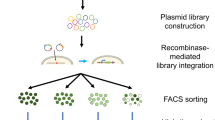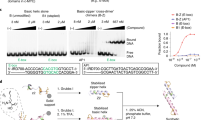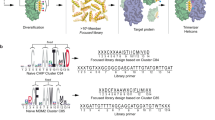Abstract
Human gene therapy approaches involving transcription factors often rely on artificial activation domains for transcriptional activation. These domains are often large (e.g., 80 amino acids for VP16), recruit multiple co-activation complexes at once, and offer no fine control over the level of transcription. In an attempt to understand the sequence and structural requirements of a minimal mammalian activator, we employed a molecular diversity approach with a peptide phage display library composed of random eight–amino acid peptides. Using the KIX domain of the mammalian co-activators p300 and CBP as target, we discovered a family of synthetic binding peptides. These peptides share significant homology with natural KIX domain ligands, and are shown to bind an overlapping, yet distinct, surface of p300/CREB-binding protein (CBP). When fused to a heterologous DNA binding domain, these synthetic peptides function as titratable, modular, and potent transcriptional activators in living cells through specific recruitment of p300/CBP, with the level of transcriptional activation proportional to the affinity of the synthetic peptide for the KIX domain. Taken together, our data demonstrate that a molecular diversity approach can be used to discover minimal, co-activator domain-specific synthetic activators, and that transcriptional activation can be modulated as desired at the level of co-activator recruitment.
This is a preview of subscription content, access via your institution
Access options
Subscribe to this journal
Receive 12 print issues and online access
$209.00 per year
only $17.42 per issue
Buy this article
- Purchase on SpringerLink
- Instant access to full article PDF
Prices may be subject to local taxes which are calculated during checkout




Similar content being viewed by others
References
Blancher, C. & Harris, A.L. The molecular basis of the hypoxia response pathway: tumour hypoxia as a therapy target. Cancer Metastasis Rev. 17, 187–194 (1998).
Leor, J. et al. Gene transfer and cell transplant: an experimental approach to repair a ‘broken heart’. Cardiovasc Res. 35, 431–441 (1997).
Kurtz, T.W. & Gardner, D.G. Transcription-modulating drugs: a new frontier in the treatment of essential hypertension. Hypertension 32, 380–386 (1998).
Pfeilschifter, J. & Muhl, H. Immunopharmacology: anti-inflammatory therapy targeting transcription factors. Eur. J. Pharmacol. 375, 237–245 (1999).
Bohl, D. & Heard, J.M. Transcriptional modulation of foreign gene expression in engineered somatic tissues. Cell Biol. Toxicol. 14, 83–94 (1998).
Sadowski, I., Ma, J., Triezenberg, S. & Ptashne, M. GAL4-VP16 is an unusually potent transcriptional activator. Nature 335, 563–564 (1988).
Cousens, D.J., Greaves, R., Goding, C.R. & O'Hare, P. The C-terminal 79 amino acids of the herpes simplex virus regulatory protein, Vmw65, efficiently activate transcription in yeast and mammalian cells in chimeric DNA-binding proteins. EMBO J. 8, 2337–2342 (1989).
Ptashne, M. & Gann, A. Transcriptional activation by recruitment. Nature 386, 569–577 (1997).
Herr, W. The herpes simplex virus VP16-induced complex: mechanisms of combinatorial transcriptional regulation. Cold Spring Harb. Symp. Quant. Biol. 63, 599–607 (1998).
Radhakrishnan, I. et al. Solution structure of the KIX domain of CBP bound to the transactivation domain of CREB: a model for activator:coactivator interactions. Cell 91, 741–752 (1997).
Parker, D. et al. Analysis of an activator:coactivator complex reveals an essential role for secondary structure in transcriptional activation. Mol. Cell 2, 353–359 (1998).
Paige, L.A. et al. Estrogen receptor (ER) modulators each induce distinct conformational changes in ER alpha and ER beta. Proc. Natl. Acad. Sci. USA 96, 3999–4004 (1999).
Norris, J.D. et al. Peptide antagonists of the human estrogen receptor. Science 285, 744–746 (1999).
Wang, B.S. & Pabo, C.O. Dimerization of zinc fingers mediated by peptides evolved in vitro from random sequences. Proc. Natl. Acad. Sci. USA 96, 9568–9573 (1999).
Parker, D. et al. Role of secondary structure in discrimination between constitutive and inducible activators. Mol. Cell. Biol. 19, 5601–5607 (1999).
Cardinaux, J.R. et al. Recruitment of CREB binding protein is sufficient for CREB-mediated gene activation. Mol. Cell. Biol. 20, 1546–1552 (2000).
Peers, B., Leonard, J., Sharma, S., Teitelman, G. & Montminy, M.R. Insulin expression in pancreatic islet cells relies on cooperative interactions between the helix loop helix factor E47 and the homeobox factor STF-1. Mol. Endocrinol. 8, 1798–1806 (1994).
Seipel, K., Georgiev, O. & Schaffner, W. A minimal transcription activation domain consisting of a specific array of aspartic acid and leucine residues. Biol. Chem. 375, 463–470 (1994).
Cantley, L.C. The impact of genome sequencing on drug discovery. In Solid phase synthesis: a practical guide. (eds Kates, S.A. & Albericio, F.) xv–xx (Marcel Dekker, New York; 2000).
Uesugi, M., Nyanguile, O., Lu, H., Levine, A.J. & Verdine, G.L. Induced alpha helix in the VP16 activation domain upon binding to a human TAF. Science 277, 1310–1313 (1997).
Uesugi, M. & Verdine, G.L. The alpha-helical FXXPhiPhi motif in p53: TAF interaction and discrimination by MDM2. Proc. Natl. Acad. Sci. USA 96, 14801–14806 (1999).
Briesewitz, R., Ray, G.T., Wandless, T.J. & Crabtree, G.R. Affinity modulation of small-molecule ligands by borrowing endogenous protein surfaces. Proc. Natl. Acad. Sci. USA 96, 1953–1958 (1999).
Nyanguile, O., Uesugi, M., Austin, D.J. & Verdine, G.L. A nonnatural transcriptional coactivator. Proc. Natl. Acad. Sci. USA 94, 13402–13406 (1997).
Mapp, A.K., Ansari, A.Z., Ptashne, M. & Dervan, P.B. Activation of gene expression by small molecule transcription factors. Proc. Natl. Acad. Sci. USA 97, 3930–3935 (2000).
Nagahara, H. et al. Transduction of full-length TAT fusion proteins into mammalian cells: TAT-p27Kip1 induces cell migration. Nat. Med. 4, 1449–1452 (1998).
Schwarze, S.R., Ho, A., Vocero-Akbani, A. & Dowdy, S.F. In vivo protein transduction: delivery of a biologically active protein into the mouse (see comments). Science 285, 1569–1572 (1999).
Kay, B.K., Winter, J. & McCafferty, J. (eds) Phage display of peptides and proteins: a laboratory manual. (Academic Press, San Diego, CA; 1996).
Frangioni, J.V. & Neel, B.G. Solubilization and purification of enzymatically active glutathione S-transferase (pGEX) fusion proteins. Anal. Biochem. 210, 179–187 (1993).
Behre, G., Smith, L.T. & Tenen, D.G. Use of a promoterless Renilla luciferase vector as an internal control plasmid for transient co-transfection assays of Ras-mediated transcription activation. Biotechniques 26, 24–26, 28 (1999).
Parker, D. et al. Phosphorylation of CREB at Ser-133 induces complex formation with CREB-binding protein via a direct mechanism. Mol. Cell. Biol. 16, 694–703 (1996).
Bertherat, J., Chanson, P. & Montminy, M. The cyclic adenosine 3′,5′-monophosphate-responsive factor CREB is constitutively activated in human somatotroph adenomas. Mol. Endocrinol. 9, 777–783 (1995).
Egan, C. et al. Mapping of cellular protein-binding sites on the products of early-region 1A of human adenovirus type 5. Mol. Cell. Biol. 8, 3955–3959 (1988).
Acknowledgements
We thank Daniel S. Kemp (MIT) for assistance with molecular modeling and peptide helicity issues, Brian K. Kay (University of Wisconsin) and Keyong Du (Joslin Diabetes Center) for many helpful discussions, David Parker for GST/KIX domain mutants and assistance with fluorescence polarization, Paul K. Brindle (St. Jude's) for c-Myb reagents, Susan Taylor (UC San Diego) for protein kinase A, Ron Evans (Salk Institute) for the G5B-luciferase plasmid, Katiri W. Wagner, Xu Mei Li, and Floretta V. Lake for technical assistance, and Ligita Stukuls and Chi Lam for administrative assistance. J.V.F. is a postdoctoral fellow of the Howard Hughes Medical Institute, and is also generously supported by the Paul D. and Lovie S. Kemp Career Development Fund for Prostate Cancer, the Hershey Family Foundation, and the Rita Leabman Memorial Fund. M.R.M. and L.C.C. (GM 56203) are supported by grants from the NIH.
Author information
Authors and Affiliations
Corresponding author
Rights and permissions
About this article
Cite this article
Frangioni, J., LaRiccia, L., Cantley, L. et al. Minimal activators that bind to the KIX domain of p300/CBP identified by phage display screening. Nat Biotechnol 18, 1080–1085 (2000). https://doi.org/10.1038/80280
Received:
Accepted:
Issue Date:
DOI: https://doi.org/10.1038/80280



